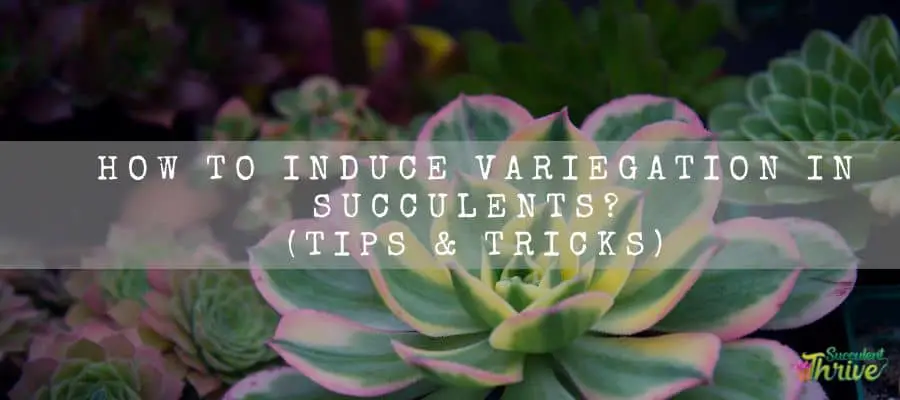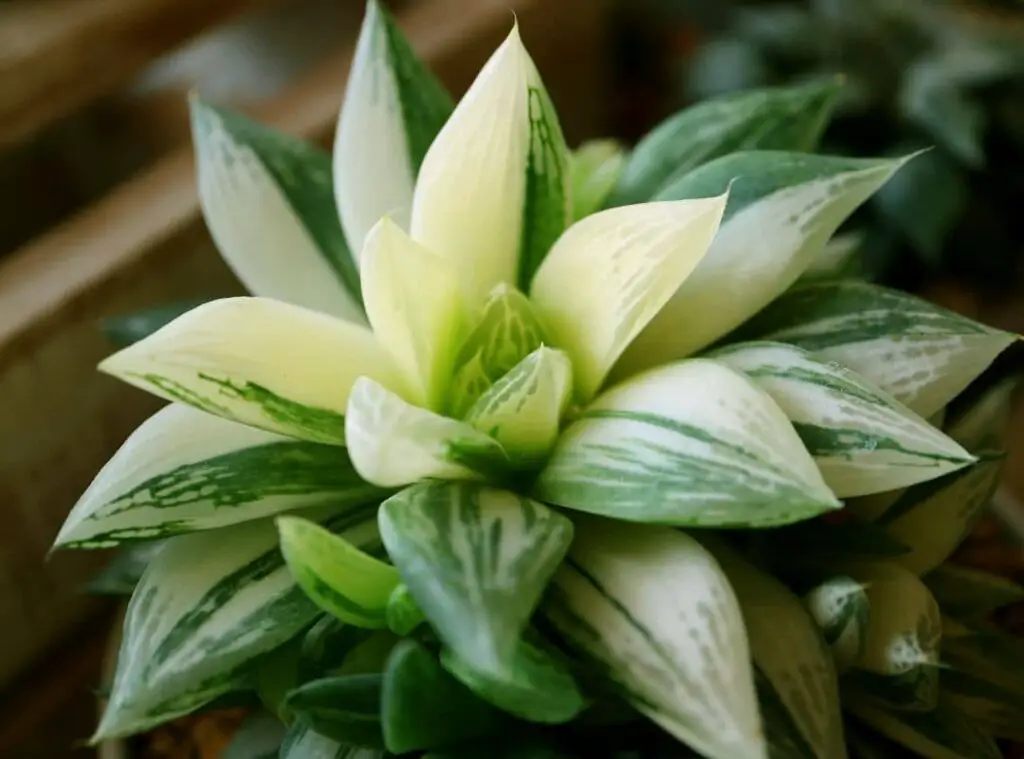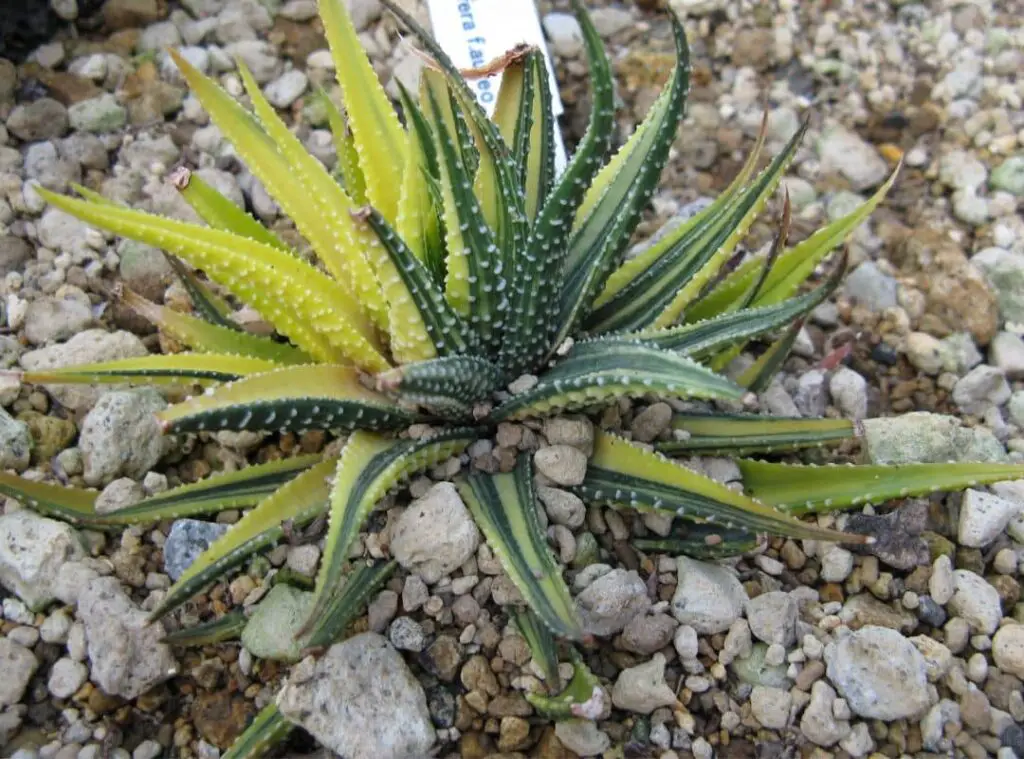How to induce variegation in succulents? If I briefly explain the methods, you can do it by using the stem cuttings, lights or even by using hormones such as auxin.

Variegation is something which could make the succulents look in attractive colors. In simple words, variegation is more like the formation of the white- or yellow-colored streaks in the green leaves.
This feature makes them look exceptional among all other one toned houseplants. Further it is noteworthy that variegated leaves are tolerant of lower light compared to other succulents.
You could do several things if you wish to have variegated plants. Either you purchase already variegated succulents or do it on your own by using several methods.
How to induce variegation in succulents by cuttings?
If you wish to make more plants, you can simply take leaves and lay them around the moist soil for some time.
The duration you need to keep the leaves on the moist soil would vary on several facts.in fact, the more you keep the leaves on the moist soil, the more prominent pale color it would get.
However, before you do this step, you need to apply the auxin hormone. Alternatively, you may also apply indole-3-butyric acid also to do this task. You need to apply this for about two weeks so that you will have high success.
Furthermore, keep in mind that if you use stem cuttings and leaf cuttings in water, it will not induce variegation. That said, you can still make new plants using water.
You only have to remove the leaves and let them wither. It would take about three months to form a plant. If you are using stem cuttings, chances are that it may take even longer to form roots.
If you wish to know whether your cuttings have rooted, you could simply watch the new growth forming out from the soil.
Once you saw them develop new growths, you could transplant them into soil. Next you can place them under artificial light. Alternatively, you may also use filtered sunlight to do this task. Finally, you can move them outdoors in summer.

How to induce variegation in succulents by hormones?
If you wish to induce variegation in succulents by using hormones, you need to first obtain some leaves which have started to dye off.
You need to ideally wait until you get your desired look of the pale color. In fact, if you expose them for longer hours, it will literally expose them for more auxin. This is what is crucial in variegation.
If you are wondering how to apply the auxin to your plants, you can do it via using IBA. Auxin is a plant hormone which has a greater impact in growing the roots as well as the shoots.
So, you could apply for IBA as it comprises Auxin. You may simply place the leaves which have stem parts attached to it in a water filled container.
Next add IBA to it. If I further be more precise, you can use ½ – 1 teaspoon of the hormone into one cup of water. However, you need to change the amount depending on the different types of the plants.
If I further elaborate further on this, a ficus plant would want a different dose when comparing them with the Jade plants.
Generally speaking, it would take about two to four weeks to form new shoots. Having said that, the duration to form new shoots would depend on the natural growth cycle of the plants as well. usually within one weeks’ time you can spot a clear difference in the color.
If you are wondering as to how long they would keep their variegated colors, you could see them carrying a slowly dying back of the leaf edges when they finish the process.
However generally speaking it would take about two weeks’ time to dye off the color completely.
How to induce variegation in succulents by light ?
If you want to induce variegation in succulents by using light, it will make all your leaves look in pale color.
In fact, what you do is just place the plants in a spot where they can gain filtered sunlight. Alternatively, you may also keep them in a yellow glass as well. if you want to have very dark leaves, you can simply place the plants exposed to direct sunlight.
If you fail to provide ample sunlight, chances are that it may not produce the new growths of the plants at all.
However, if you go through something like this, you need to enhance the sunlight levels on a daily basis in a consistent manner so that you could spot a significant change in the color.
How to induce variegation in succulents by radiation ?
If we briefly look into how radiation induces variegation in succulents, it is more like exposing the rooted cuttings to high levels of energy electromagnetic radiation.
You could do radiation either via the form of gamma rays or as x rays. This can instigate the chemical changes in the plants as it would literally disrupt the structure of DNA.
The exposure for radiation can cause variegation in the plants. Furthermore, it can also enhance the growth of the number of branches as well. Not only that but also it can enhance the number of flowers, the sizes of the flowers and the leaves too.

Can you induce variegation in succulents by chemicals?
We don’t have a lot of information available on inducing variegation in succulents by using chemicals.
However, if we briefly touch on the houseplants on how it works, the chimeric variegation in houseplants would usually happen once the genetically distinct tissues come in place next to one another.
This would ultimately result in a fresh color formation in the leaves and in the flowers as well.
Variegated plants have a higher demand when you compare them with other regular plants. Since the demand is high, they are sold at higher prices. So, inducing the variegation of plants using chemical means can be done in different ways and means.
For example, you can use chemical mutagens like Ethyl methanesulfonate for this. Furthermore, you may also use ionized radiation for this just as we described in the above. Last but not least, we can transpose genes from one plant to another plant too.
However, using chemical methods to induce variegation is somewhat a complicated process. Further it is not safer to do so, especially at home.
Practicality wise, it is somewhat less realistic when you do it on your own at home. If you are a gardener, best is to wait until they come up with a unique phenotype.
If we briefly look into this, chimera place usually produces through nuclear genetic changes or by chloroplast genome.
They could occur either spontaneously or by inducing. Many commercial plant breeders tend to use the chemical mutagen called Ethyl methanesulfonate to induce beneficial mutations. They would usually apply it on the hydrated and metabolically active seeds.
What they would usually do, they would soak them in a solution of EMS for about 6-12 hours. In addition to that, they tend to soak the young seedlings’ roots in a low concentration of EMS for a shorter period.
However, if you use this method, you cannot rely on the fact whether the mutation would become phenotypically expressed or whether it will form distinctive colors.
Further it may also cause the changes in the foliage of the plants. So, chances are that you may have to practice these methods for so many times and then get the desired variation you want to have.
That being said, if you supply the plants with excess chemicals, chances are that it can impact on the energy production of the plants.
Literally it can prevent the plants in creating further energy for survival too. If you are trying this out on a slow growing plant, it can result in a devastating effect on the plants.
Read Next : Can You Bring Cactus On A Plane? (Yes, Of Course)
